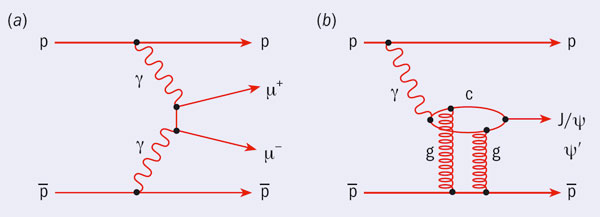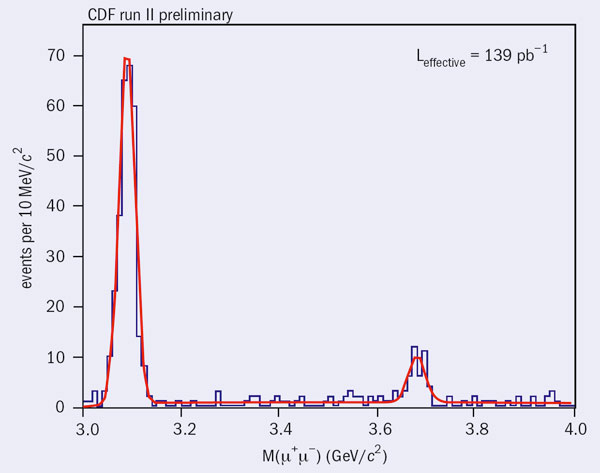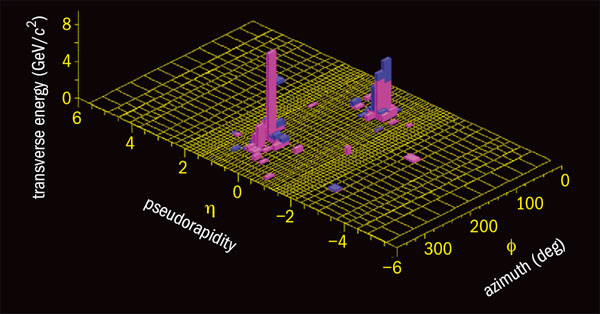Groundbreaking work at the Tevatron
Most reactions at Fermilab’s Tevatron occur when the colliding proton and antiproton break apart into quarks and gluons that hadronize to form the particles that fly off into the detector. In exclusive interactions, however, the proton and antiproton avoid the breakup, glancing off each other in a process where the underlying interaction involves some combination of photons and/or gluons.

In 2006, the CDF collaboration at the Tevatron obtained the first clear evidence for exclusive interactions at a proton–(anti)proton collider, when they observed high-energy photon pairs in the central rapidity (barrel) region of the detector, but with nothing else, down to an angle of around 0.1° from the beam (±7.4 units of pseudorapidity). They found only three events initially, against a small background predicted to be at most 0.2 events (Aaltonen et al. 2007). These events were consistent with being produced via gluon–gluon “fusion” via a quark “box” where the gluons originate from the beam particles, as shown in figure 1a. An additional “screening” gluon is exchanged to cancel the colour of the interacting gluons and allow the leading hadrons to stay intact. The collaboration has since observed more exclusive two-photon final state candidates in new data.
The search for this unusual two-photon process at the Tevatron was originally proposed in 2001, when CDF physicists first explored the possibility that the Higgs boson could be produced by gluon–gluon fusion as described in figure 1b (Albrow et al. 2005). The idea is that if the Higgs field fills the vacuum, it should be possible to “excite the vacuum” into a real Higgs particle in a glancing collision of a proton and antiproton. Theorists had various estimates for the probability of this happening, but their predictions varied widely.
The two-photon process measured in the CDF detector is produced in much the same way as the Higgs would be, but much more prolifically, so making it a “standard candle” for the production of Higgs bosons. Theorists from the Centre for Particle Theory at the University of Durham predicted that there should be only about one clean two-photon event of this kind in data corresponding to 532 pb–1 of integrated luminosity taken by CDF in Run II at the Tevatron (Khoze et al. 2006). The three events that the CDF collaboration found confirmed this prediction. Thus, the similar process that could produce the elusive Higgs boson must also happen, and could be measured at the LHC, thereby providing measurements of the particle’s mass, spin and other properties.

In the process of checking this measurement, the CDF physicists came across another exclusive physics process that had never been seen before at a proton–(anti)proton collider. They found 16 events that are consistent with the QED prediction that photons travelling with the proton and antiproton can interact to produce only an electron–positron pair (γγ → e+e–) without breaking up the proton and antiproton (Abulencia et al. 2007). In this case the Tevatron acts as a photon “collider”. As the backgrounds to this process are similar to the final state discussed above, the CDF team gained further confidence in their exclusive two-photon final state analysis. To date, they have found many more exclusive electron–positron candidate events. QED two-photon processes such as this, which have previously been observed in electron–positron, electron–proton and nuclear collisions, should provide a means of calibrating the momentum scale and resolution of forward proton spectrometers proposed for the ATLAS and CMS experiments at the LHC.
The CDF team then reasoned that they should also see exclusive muon-pair events produced by the same QED interaction, as in figure 2a. Apart from an indication of exclusive pair production at the ISR at CERN (Antreasyan et al. 1980), this would be another “first” at a proton–(anti)proton collider. In 2007 their supposition was confirmed, but with an added bonus. The expected process, γγ → μ+μ–, was indeed detected according to QED expectations.
In addition, the CDF physicists recorded, for the first time in hadron-hadron collisions, exclusive photoproduction of the J/ψ and ψ (2S) decaying to a pair of muons (figure 2b). Figure 3 shows the clear, clean signals observed. The team also detected the contribution from exclusive production via gluon–gluon fusion of the χc0, decaying to a muon pair and a soft photon (figure 1c). Evidence for this state in CDF data had also been reported earlier, in 2003 (Wyatt 2003).
An analysis aimed at higher muon-pair masses also revealed the upsilon (Υ). The Υ(1S) and Υ(2S) have been clearly seen in CDF, with the Υ(3S) emerging, to be revealed by the higher statistics that are now available. In the case of the photoproduction of these bottomonium (Υ(1S), Υ(2S)) and the charmonium (ψ(1S), ψ(2S)) states, the Tevatron is acting as a “photon–pomeron collider” (figure 2b). The pomeron is well known from diffractive reactions, which are characterized by the exchange of a quark/gluon construct – the pomeron – with the quantum numbers of the vacuum. Because the exchange is colourless, in these reactions a large region in pseudorapidity space is left empty of particles (the “rapidity gap”). In perturbative QCD, the lowest order prototype of the pomeron is a colour-neutral system of two gluons.

Image credit: CDF collaboration.
This photoproduction of charmonium and bottomonium was previously studied in collisions at DESY’s electron–proton collider, HERA, with similar kinematics (√s = 100 GeV) and the cross sections are in agreement. A comparison of the J/ψ and ψ(2S) cross sections with predictions from HERA data is sensitive to a possible contribution from the elusive and enigmatic odderon. This is a partner of the pomeron with charge conjugation odd (C-odd) and in QCD is formed from three gluons in a colour-neutral state. Unfortunately these predictions have a spread, weakening the sensitivity of CDF’s search for odderon exchange, but still allowing a useful limit to be set on the production of odderons in this mode.
After publishing results on exclusive lepton-pair and photon-pair production, the CDF collaboration scored a hat-trick in 2008 when it published results on exclusive di-jet production, as in figure 1d (Aaltonen et al. 2008). Using a Roman Pot deployed tracker some 66 m from the interaction point to tag the unbroken antiproton in conjunction with a large rapidity gap on the deflected proton side, the team defined a sample of potentially exclusive events. The greater the share of the mass of the central system that the two jets enjoyed, the “more exclusive” the events were expected to be. This expectation was borne out by the Monte Carlo simulation (Monk and Pilkington 2005) for central exclusive production and in agreement with the predictions of the Durham Group (Khoze et al. 2007). Figure 4 shows an event display of an exclusive di-jet candidate. Also, as the di-jet fractional share of the overall central mass of the event tended to one – and the exclusive di-jet sample became purer and purer – evidence for b-jet suppression was seen, as theoretically expected. As in the case of exclusive gamma-gamma and χc0 production, this is an example of the Tevatron acting as a gluon–gluon collider. The detection at the Tevatron of these exclusive processes, resulting from gluon–gluon interactions, strongly suggests that exclusive production of the Higgs boson by the similar process would be detected at the LHC.

Image credit: CDF.
Although forward proton detectors have been used to study Standard Model physics for a couple of decades, the new landscape revealed by exclusive physics at hadron colliders has been fully realized only in the past few years. In this arena, the LHC is not only preparing to take the baton from the Tevatron, but also to enter the race with greatly improved tools. The FP420 R&D project is planning to provide the means to measure the displacement and angle of the outgoing protons from exclusive interactions by deploying high precision “edgeless” silicon trackers less than a centimetre from the beam, at ±420 m from the beam intersection points of the ATLAS and CMS experiments at the LHC (Albrow et al. 2008). This gives these experiments the ability to calculate the proton momentum loss and transverse momentum, allowing the mass of the centrally produced system to be reconstructed with a resolution of a few GeV/c2 per event whatever the central system. Broadly speaking then, in the exclusive physics arena, the LHC becomes a “multi-collider”, where the gluon–gluon, photon–photon, or photon–pomeron beam energy is known.
The ability of the FP420 detectors to measure intact protons from an exclusive interaction, in conjunction with the associated centrally produced system using the current ATLAS and/or CMS detector, will provide rich new perspectives at the LHC on studies in QCD, electroweak physics, the Higgs sector and beyond Standard Model physics. In some scenarios, these detectors may be the primary means of discovering new particles at the LHC, with unique ability to measure their quantum numbers. The addition of the FP420 detectors will thus, for a relatively small cost, significantly enhance the discovery and physics potential of the ATLAS and CMS experiments. The existence proof provided by the exclusive physics results from the Tevatron shows that such a programme is feasible.








